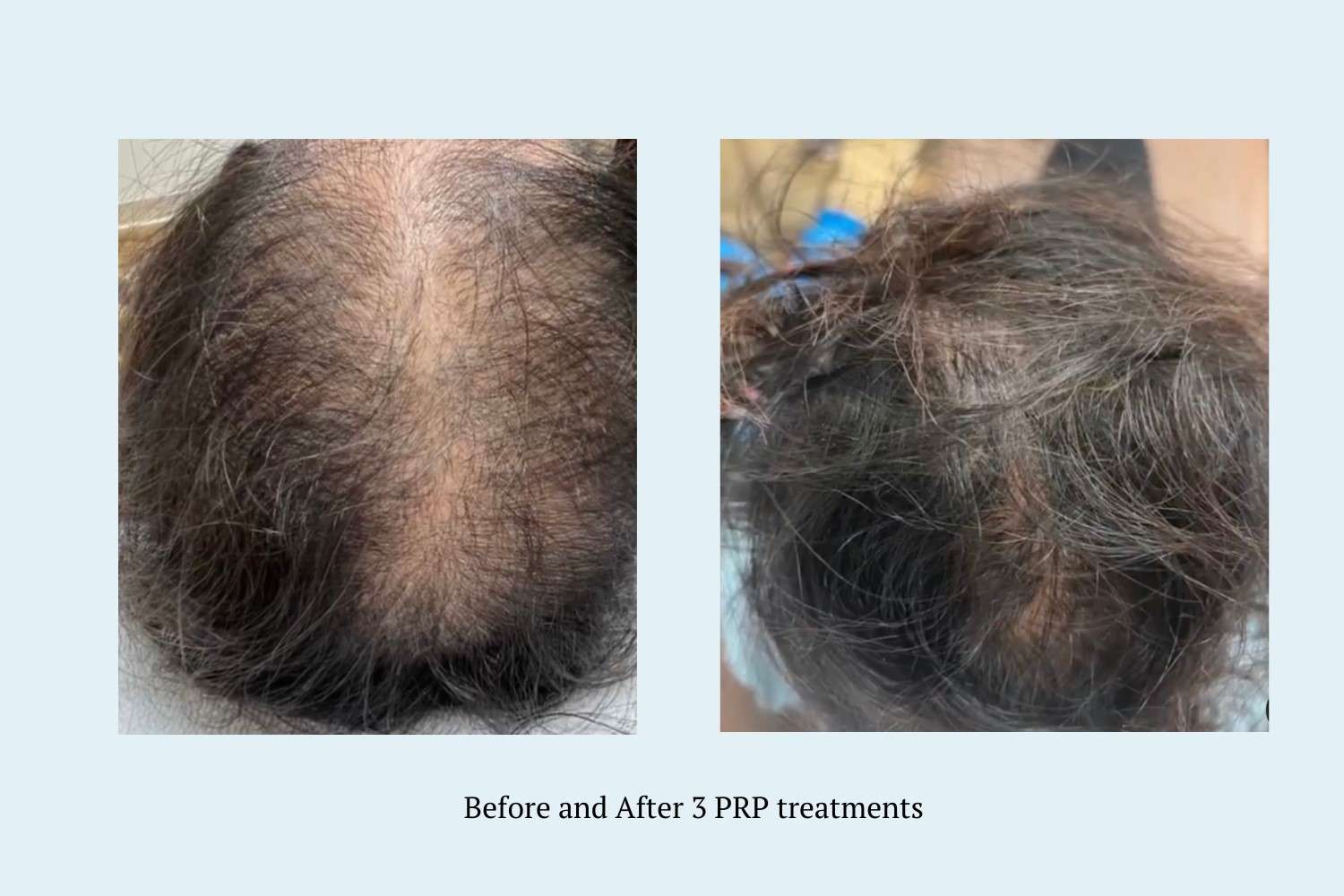Loosing hair can affect self esteem, it is not uncommon for people to hide their hair loss. Female pattern hair loss” is a form of hair loss that affects women. It is caused by hormones, genetics, and age. While the condition is not completely reversible, there are several treatments available that can help to slow the progression of hair loss. These treatments and even encourage hair regrowth. These treatments include medications, lifestyle changes, and even surgery.
What is Female Pattern Hair Loss?
Female alopecia unfortunately is not uncommon and female hair loss stress is more common than you think. According to Alopecia UK it affects 50% of women over the age of 65.
Female pattern hair loss (FPHL) is often by is caused by an inherited genetic predisposition. FPHL is also known as alopecia in women , or hair loss in women. It affects millions of women around the world and often begins after menopause. This type of alopecia in women affects the hair follicles which are responsible for creating new hairs.
In FPHL, the hair follicle become smaller and gradually produce fine, shorter hairs that eventually do not grow at all. This results in thinning of the hair around the top of the head and a receding hairline. The sides and back may remain unaffected by this alopecia (female pattern baldness). T as they contain stronger hair follicles than those found on the crown. This type of alopecia is more common in women than men, but it can also affect both genders. Treatments for FPHL include medications and topical treatments as well as lifestyle changes such as eating a healthy diet and avoiding environmental factors that may cause alopecia. Treatment plans are tailored to each individual’s unique needs,
What causes female-pattern baldness?
Female-pattern baldness is caused by androgenetic alopecia, a hereditary hair loss condition that involves the production and activity of androgens, male hormones that are found in both men and women. In other words, these women have too much male hormone. The main androgens responsible for FPHL are dihydrotestosterone (DHT) and testosterone. DHT binds to androgen receptors in the hair follicles and causes them to shrink, leading to a decrease in the production of new hairs, further hair loss and eventual balding.
Other factors that can contribute to FPHL include hormonal imbalance, stress, and medical conditions such as thyroid disease and alopecia areata. These can lead to sudden hair loss. Additionally, traction alopecia can cause FPHL in those who wear their hair pulled back or tightly braided for extended periods of time. This excessive pulling causes traction on the hair follicles, the hair follicle shrinks, leading to a gradual thinning of the hair over time.
Other causes of FPHL include iron deficiency, skin disease or skin disorders, hair and nail disease, or an underlying medical disorder, and skin irritation.
Signs of female-pattern baldness (hair loss in women)
Noticeable hair loss in male or female pattern baldness typically include thinning hair, temporary hair loss, or patchy hair loss. These thinning areas may appear on the top of the head, at the crown, or along the front of the scalp. The thinning of hair often starts at a slow rate and can progress to more extensive baldness over time. Women may also experience thinning in other areas such as the eyebrows, or a thinning of the hairline. In some cases, hair loss in women may also be accompanied by thinning at the temples and thinning behind the ears. These women notice their hair follicles shrink with time. Hair loss rarely progresses to complete baldness.
While it is common for women to experience thinning hair throughout their lives, it can become more noticeable with age. Women should monitor any changes in their hair follicle and consult a doctor if they are concerned about thinning or patchy hair loss. With proper diagnosis and treatment, female-pattern baldness can be managed.
Male-pattern baldness in women
It is important to note that male-pattern hair loss affects both men and women, but it is more common in male individuals. Male-pattern hair loss usually has a genetic component, meaning that if you have a family history of male pattern baldness, there is an increased chance that you may lose hair and experience male or female patterns of hair thinning as well. Most often many in the family experienced hair loss. Male-pattern baldness in women typically occurs at the top of the head and forehead, where hair thins and recedes. The thinning often results in a horseshoe shape around the sides of the face or a “widow’s peak” at the front of the scalp. Women may also experience male-pattern baldness at the temples, where hair thins and recedes.
In order to diagnose male-pattern baldness in women, a doctor will usually take a medical history and physical examination. They may also perform blood tests to check for deficiencies that can affect hair growth or a skin biopsy to rule out any underlying skin conditions that could be causing hair loss.
Diagnosis of Female Pattern Hair Loss
Female Pattern Hair Loss (FPHL) is a hair loss condition that affects women of all ages. It can be characterized by hair shedding, hair falls, and the appearance of missing hair in certain areas of the scalp. To diagnose FPHL, a doctor will perform a physical exam and take into consideration any medical history or family history when determining the cause. The doctor may also do a hair pull test, which is when they gently tug on small sections of hair to check for hair shedding or hair falls. If you have skin conditions, the doctor may need to diagnose skin disorders.
In some cases, a scalp biopsy may be necessary to confirm the diagnosis. During this procedure, a small sample of scalp tissue will be taken and sent to a lab for testing. The results of the hair pull test, medical history, and scalp biopsy will be used to determine an accurate diagnosis of FPHL.
Once a diagnosis has been made, treatment options can begin to be discussed.
What kind of hair loss is reversible?
Hair loss can be a difficult and emotionally challenging experience. Fortunately, there are some types of hair loss that are reversible with the right treatments. Receding hairlines and other forms of thinning hair due to genetics or aging can often be managed through solutions such as weaving in hair extensions or using topical medications. Additionally, certain types of hair loss caused by physical stress or tension — such as traction alopecia, which is common amongst women who wear their hair in tight styles like braids and ponytails — can be reversed with more gentle styling practices. It is important to consult a dermatologist if you suspect that your hair loss could be due to any of these causes in order to determine the best course of treatment for your specific condition.
With timely and appropriate care, it is possible to reverse hair loss and restore a healthy looking head of hair.
It is important to remember that not all types of hair loss are reversible. Some issues, such as male/female pattern baldness or alopecia areata, are more difficult to treat and require long-term care. For these conditions, it is important to speak with a hair specialist to determine the best course of action for your individual needs.
Can Female Pattern Hair Loss be Reversed?
The short answer to this question is yes. Female pattern hair loss, or androgenic alopecia, is the most common type of hair loss in women, and it can be reversed with proper medical treatment. This condition occurs when missing hair due to miniaturized follicles caused by hormones like testosterone and their derivatives. When the affected follicles shrink, the hair growth cycle is disrupted and new hair growth is limited.
On the other hand, autoimmune conditions which cause hair and nail diseases can be very difficult to treat and can cause permanent hair loss.
Medical Treatments to Regrow Hair
Medical treatments for female pattern hair loss can help stimulate new hair growth and reduce hair shedding. There are a variety of treatments available, each with its own risks and benefits.
Topical Minoxidil
One popular treatment is minoxidil, which is applied directly to the scalp twice a day. Minoxidil can be used to stimulate healthy scalp skin, promote new hair growth, as well as reduce shedding. It’s a relatively safe treatment with minimal side effects; however, it can take months before the hair grows back.
PRP (Platelet Rich Plasma)
Another option is platelet-rich plasma (PRP) therapy. This treatment uses the patient’s own blood cells to create a serum that is injected into the scalp. This serum contains growth factors that can stimulate hair follicles, resulting in new hair growth and prevent hair breakage. PRP is an effective treatment for female pattern hair loss. PRP can thicken hair, and treat several types of hair disorders.
Other Treatments
Hair Transplant
Hair transplants are also an option for those with female pattern hair loss. This approach involves surgically transferring healthy hair follicles from one area of the scalp to another. Hair transplant a more permanent solution, but requires a significant financial investment and recovery time.
Hormones
Hormone therapy is another option to treat female pattern baldness. By manipulating hormone levels, hair growth can be stimulated. This treatment is typically used for postmenopausal women who have an imbalance of hormones that can cause hair loss. Hormone therapy can be effective but should only be done under the supervision of a doctor as it carries certain risks.
Lifestyle change
For female pattern baldness, lifestyle changes can also help reduce hair shedding. Eating a healthy diet, quitting smoking, and reducing stress levels can all improve hair growth and reduce hair loss. Additionally, taking certain supplements, such as biotin or saw palmetto, may stop hair shedding, improve the quality of the hair shaft and stimulate hair growth.
The best treatment for female pattern hair loss will depend on the individual’s age, health, and the severity of their hair loss. It is important to talk to a doctor before beginning any treatment plan. With proper care and medical treatments, it is possible for women to experience new hair growth and reduce hair shedding. No need to hide hair loss, you can stop losing hair, regrow your lost hair, have thicker hair and be confident again.
Have Questions?
Contact our office Voyage MedSpa and wellness in St. Petersburg, FL at 727-498-6992. We would be happy to answer any questions you have and schedule an appointment. Voyage MedSpa is a premier medical center and med spa in St Pete FL with services for hair loss treatment.
Click here to request an appointment










